
Pumpkin Saver
Course Project on battling food waste within a community for INF1602 at the University of Toronto.

The team: A group of five UX designers, taking turns leading different parts of the research, design, creation of presentation slides, conducting interviews, and recruiting participants.
My role: created visuals, contributed to the proofreading and editing of the copy for the deliverables and researched pathways for ideation.
Tools used: Adobe Illustrator, Figma, Canva, Microsoft PowerPoint, Procreate, paper, and pens.
Problem
The current state of food waste has focused primarily on perishable foods and food spoilage.
Our project will address this gap by saving purchased food without waste.
Our initial focus will be providing food measurement, tracement, and advisable recipes as solutions.
Goal
The Case Scenario is an individual has a budget for food consumption
Somewhat like bridging the gap between the need to purchase affordable foods for smaller quantities and the reality that most foods are more affordable if bought in bulk.
We have observed that the product/service is not meeting the logging food purchase, automatically calculating expiration dates, and reminding food quality via notification, which is causing insufficient customization to reduce food waste.
Research
Secondary Research
We primarily employed online research methods, focusing on both quantitative and qualitative research to get a better understanding of not only the gravity of the issue but also the current public sentiment. Our materials are related to food costs and waste within the domestic context of Canada. This included examining academic sources (scholar’s reports or studies), news, articles, blog posts, and government-funded research reports. In addition, we analyzed analogous products, such as mobile apps like "Too Good To Go," "Uber Eats," and "Yummly," as well as websites like "My Fridge Food."
Summary of Findings
Food Cost + Food Waste:
The high cost of food is a critical issue that has been a major topic of discussion in large metropolitan cities like Toronto. During COVID-19, and in a post-pandemic city, Torontonians are experiencing high costs of living. Studies have found that the cost of living will continue to rise, with food in particular rising at staggering rates, up 10.3% in 2022 (Rankin et al., 2022).
This increase in the cost of food doesn’t seem to be stopping anytime soon, as it is projected to continue to rise another 5-7% in 2023 (Montgomery, 2023).
An interesting piece of data that we found was that while the cost of food increases, food waste also continues to rise, with Canadians contributing to 400 kgs of food wasted per person each year (Weber, 2019).
In Canada, 49 billion dollars worth of food is sent to landfills each year, with 63% of this food being edible food that could have been eaten (National Zero Waste Council, 2022).
Living Alone + Bulk Buying + Food Purchasing Behaviours:
In terms of demographic trends, a significant number of people are currently living alone in Canada. This number has reached its recorded peak in 2021, with 4.4 million in total, in comparison to 1.7 million in 1981 (Statistics Canada, 2022).
As the number of single-member households steadily rises, consumers are looking for ways to cut costs, and bulk buying may feel like the solution. However, experts believe that the practice of bulk buying may actually be more expensive for shoppers in the long run and contribute significantly to food waste (Charbonneau, 2023)
In regards to bulk buying, it is suggested to split costs and items with a grocery shopping buddy to reduce food waste, especially if you live alone (Sun, n.d.).
Research has shown that food purchasing behaviors are associated with both individual and place-based characteristics in Canada and that people would take route distance and personal preference into consideration. (Widener et al., 2018).
Existing product/service analysis:
Too Good To Go: a mobile app that aims to combat food waste by connecting consumers with local restaurants, cafes, and grocery stores to purchase surplus food items at discounted prices. Notably, products provided through this platform are merchant-centric, with limited flexibility for users to make specific choices.
Uber Eats: a mobile application and website that specializes in food delivery and takeout services. While it is possible to obtain a single portion of prepared food from Uber Eats, it tends to be costly.
Yummly: a digital platform and mobile application that focuses on food and recipe discovery, meal planning, and cooking guidance. However, the extensive database of recipes on Yummly can be overwhelming for some users.
My Fridge Food: a website that helps users find recipes based on the ingredients they already have in their kitchen and fridge. It is a valuable resource recipe database but may not always account for the freshness of those ingredients, indicating a lack of freshness and food safety considerations.
Primary Research
For the primary research, we used two methods: Survey and Interview.
Description of the participants and recruitment process
Survey:
The participants in our survey consisted of single households or individuals who exclusively purchased food for themselves. To recruit these participants, we initially designed a survey form using Microsoft Forms. Subsequently, we identified potential respondents both on campus and within our personal networks. We crafted a concise and compelling recruitment message that included a link to the survey form.
Interview:
The participants in our interviews were single households or individuals who primarily purchased food for their own consumption. To recruit these participants, we began with a qualification check among individuals within our network who were readily accessible. Subsequently, we extended invitations to potential informants who expressed their willingness to participate.

In total, we got 37 responses, including 26 valid answers (completed the whole form) from the survey and 11 from the semi-structured interviews.
Description of Data Collecting Process
Survey:
Survey Question Preparation
Surveys were sent out on Oct 8, 2023, at 10:00 a.m., and we collected responses until October 22, 2023, at 3:30 p.m. The link to the survey was sent to individuals in our social networks that fit our participant criteria, as well as being posted in online student groups. Once all survey responses were collected within the agreed-upon time period, we analyzed the data by exporting the responses into an Excel spreadsheet and then importing the responses into Miro. During our thematic analysis of the survey data, each survey response was turned into a sticky note, and the sticky notes were subsequently organized by theme and grouped into clusters.
Interview:
Interview Question Preparation
Interviews were conducted between October 10th to October 17th, 2023. The participants were recruited by word-of-mouth, and no personal data was collected before, during or after the interview. The interviewer ensured that the interviewee was informed of the study protocol and consent was given before conducting the interview. This was done by following the interview guide we created as a group, which consisted of the study protocol, recruitment screener, and consent form. Once consent was obtained and participants matched the recruitment criteria, the interview was conducted. The interviews lasted between 15-20 minutes, where we asked 7 main questions, and also had a list of probing questions to help the interviewer prompt the interviewee to share an anecdotal and more nuanced response if the answers seemed short. The interviews were not recorded by the interviewer, and instead, all responses were either typed or hand-written by the interviewer. After all the members had conducted their interviews, the responses were collectively organized by users' pain points, behaviours and goals, in a Miro board. Thematic analysis was conducted by grouping responses by themes and extracting insight statements from these themes.
Information regarding interviews, including the date, facilitator, interview, and documentation method, can be found in our Interview Data Document.
Results for Survey:
Data Preparation: We had 37 participants click on the survey link, however, there were 11 participants who did not answer or pass the screening questions, thus they were not prompted to continue with the survey, and their responses were omitted from the final analysis. Therefore, only 26 participants had passed the screening questions and their responses were used in the research analysis.
Quantitative Data: We gathered quantitative data by using Microsoft Forms, which produced pie charts that allowed us to visualize the results of our questionnaire. The quantitative data provided us with the frequency with which participants purchased food and the most common shopping behaviours. Our questionnaire questions call for more nuanced and qualitative data measures, as we included several short answer questions. Thus, we were not able to use central tendency measures to quantify our results.

Qualitative Data: Grocery shopping is an integral part of daily life for individuals living alone and in need of food (Fig.1). Before heading to the stores, 12 out of 26 participants diligently plan their meals in advance, 9 of them make decisions based on cravings, and personal preferences, while 5 participants opt for spontaneous shopping without a predefined plan (Fig.2). Several factors shape these shopping decisions, encompassing price and budget considerations, dietary preferences, convenience, store location, as well as the quality and freshness of available products (Fig.3).
Challenges perceived by participants are primarily centered around price, freshness, and the necessity of products, with many noting that fresh and organic items tend to be pricier. To economize and reduce shopping frequency, more than half of the participants favour purchasing storable or freezable products in bulk.
Food waste remains a concern, often occurring when participants forget what they have stored in their fridges or encounter altered schedules and unexpected situations, despite some attempting to plan meals to mitigate this issue. Among the discarded items, fresh foods such as fruits, vegetables, and proteins are the most commonly wasted.
Notably, over 9 out of 24 participants shared that they have used food-related apps, such as Too Good To Go, Instacart, and HelloFresh (Fig.4). Reflecting personal intentions and concerns, 19 out of 25 participants expressed openness to food sharing or cooperative shopping (Fig.5), with 23 participants expressing significant concerns about the environmental impact of food waste (Fig.6).
Results for Interviews
During our interview, we transcribed data from notes to text and identified several pain points, including transportation inconveniences, inadequate grocery planning, the perishable nature of foods, high food prices, and storage challenges.
Among these, the most significant pain point is the perishable nature of foods, with a particular focus on fresh products. Many participants expressed deep concerns about their inability to consume these items before they reach their expiration dates. They also expressed a desire for affordable fresh foods and convenient ways to transport them. Currently, some participants address this issue by purchasing frozen foods or freezing fresh items. Regarding the other pain points, participants commonly resort to buying small but expensive portions frequently, shopping at nearby stores without exploring more affordable alternatives or exclusively buying non-perishable foods.
It's crucial to note that the majority of participants we interviewed were students and young professionals, and their schedules were subject to frequent changes and unpredictability. Given the escalating food prices in Canada, it is increasingly important for these individuals to improve their grocery shopping routines through better planning and devise more effective strategies for ensuring the consumability of the foods stored in their refrigerators.

Overall Summary for Findings
Participants are primarily concerned about the perishability of fresh foods, which they desire but find challenging to store and preserve, as they easily expire, often leading to food waste. The ever-changing schedules of busy individuals contribute to this issue, as fresh products stored in the fridge are frequently forgotten by those with limited time for grocery planning or meal preparation.
Our secondary research shows that given the rise in food prices in Canada over recent years, individuals often encounter challenges regarding the affordability of groceries. However, with the increased cost of food, we would hope to expect a decrease in food waste in order to mitigate the costs, but this is not the case; in fact, we are seeing that food waste is on the rise in Canada.
Our primary research reflects these same issues. However, we can see from our primary research data that individuals who live alone find that the reason why they experience food waste is because they aren’t sure how to plan effectively and purchase only enough for one person at an affordable price point. Perishable foods like produce and dairy are the most challenging food categories regarding food waste. The data also showed that individuals find bulk buying challenging due to a lack of storage and the inability to preserve such large quantities of food. We would like to begin ideating on a solution that provides users with affordable options for food that also allows users to reduce their food waste of perishable items.
In this project, we aim to find a way to help people plan and be intentional with their foods, improve their awareness of effective grocery shopping planning and enhance their ability to keep track of the items in their refrigerators.
Research Analysis
- After our 11 interviews, each of our team members organized their notes into pain points, behaviors, and motivations.
- The "Needs, Obstacles, and Desires" section reflects the most common things we heard throughout our interviews as well as the most common themes we found in our surveys.
This allowed me to create our user persona. Meet Penny Pincher!

@line.falls
Brief description:
- Master's student living alone, busy, tries to eat well-balanced home-cooked meals.
- Struggles with finishing food and planning meals, food spoils quickly, no car, and limited storage.
- Needs smaller portions, a way to cut down on food waste, and more convenient grocery shopping methods.
Based on our 11 interviews and 26 survey responses I made an empathy map where we consolidated the main points we heard and observed.
Empathy Map

- "Says" in the empathy map records the verbal responses and insights our interviewee communicates during the interview.
- Penny said she usually ends up buying more than they need because grocery shopping for one person is challenging.
- We carried out the "Thinks" section by closely observing the interviewee's reactions and inquiring about their thoughts.
- Penny prioritizes not wasting food over saving money, and wishes there was someone to split groceries with.
- Penny also addresses the difficulty in anticipating how much food she will need for the week because there is a lot of fluctuation in her busy schedule.
- The "Does" section captures Penny's behavior related to accessing, decision-making, storing, and consuming foods.
- Penny buys perishable foods in smaller quantities and more frequently and non-perishables in bulk
- Penny mainly shops based on impulse and previous patterns, while she sometimes skips meals because she is busy with her student life.
- The "Feels" section is developed based on the conversation and our observation during the semi-structured interview.
- Penny's predominant emotional state appears to be characterized by a range of negative emotions, such as worry, concern, feeling overwhelmed, and anxiety.
- Penny's journey is depicted by including planning, shopping, and consumption using an "as-is" scenario template. This approach aids in gaining insights into the user's actions, thoughts, and emotions throughout the task.
- Each member of our group was allotted three red dots to cast their votes, indicating the level of significance associated with Penny's experience.
- Based on the voting result, the most significant pain point is the big portion of one pack of food and the concern about its quality after long-time preservation.
- These two points occurred during the purchase and eat steps, which is our main focus for the following process.
Ideation
- During a meeting, each team member generated 4-5 need statements.
- Based on the pain points, we consolidated the need statements into four statements that reflected our users’ needs the most.
Meal Planning: Penny needs a way to plan her grocery shopping trip, so that she can have a detailed list of items she needs, reducing her waste.
Food Storage/Preservation: Penny needs a way to learn proper food storage/preservation techniques so that she can preserve her food for longer.
Inventory Management: Penny needs a way to remember the groceries she has in her fridge so that she can use them up (before they expire).
Grocery Shopping: Penny needs a way to shop locally so that she can spend less time commuting and sourcing her food.
- We further consolidated our Crazy 8s into 6 big ideas and 2 absurd ideas.
- 6 big ideas include "Prepared Meals," "Food Collector," "Food Sharing," "Inventory Checker," "Food Trading," and "Grocery Partners"
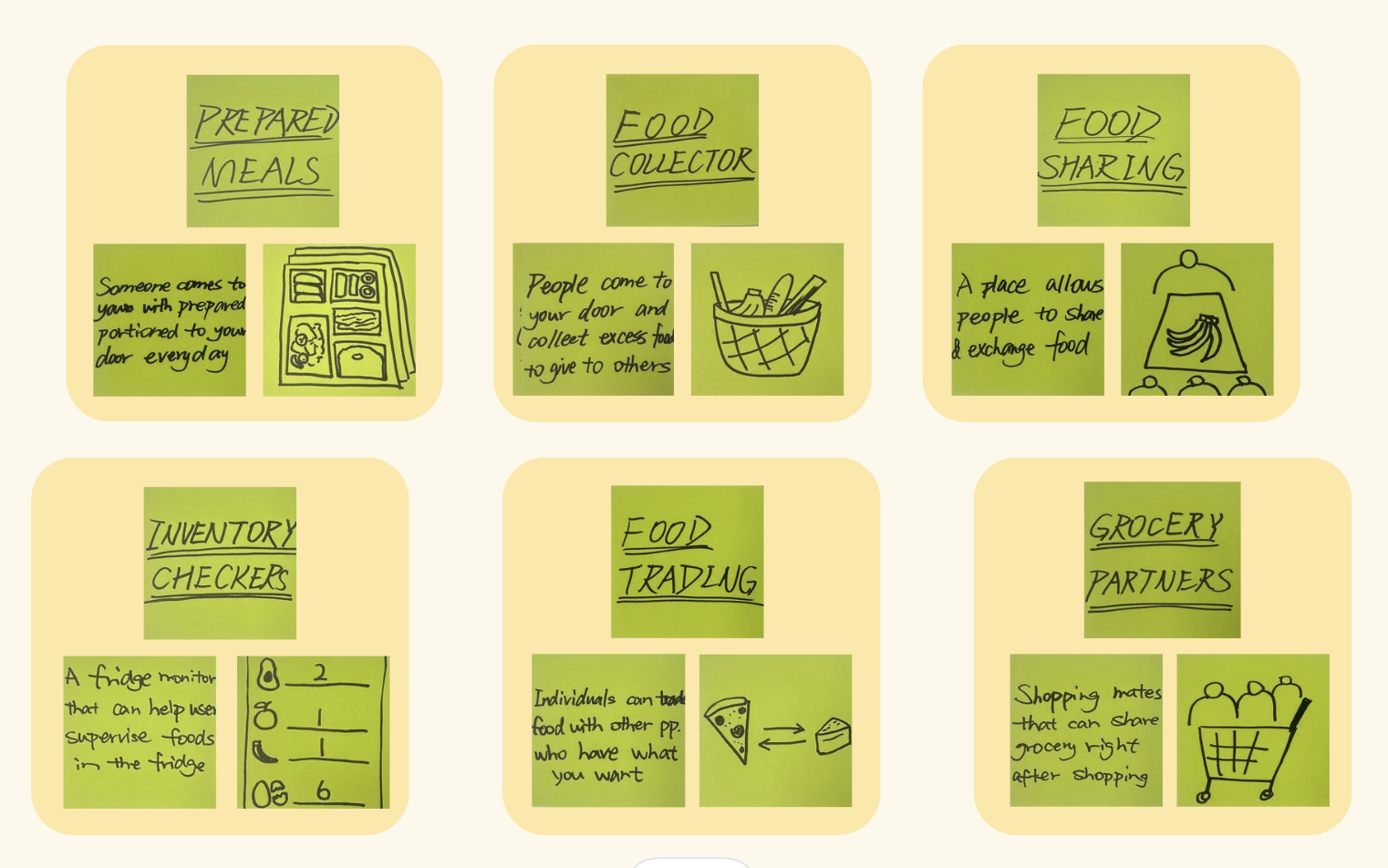
- Two absurd ideas are "Magic Fairy Chef" and "Pneumatic System."
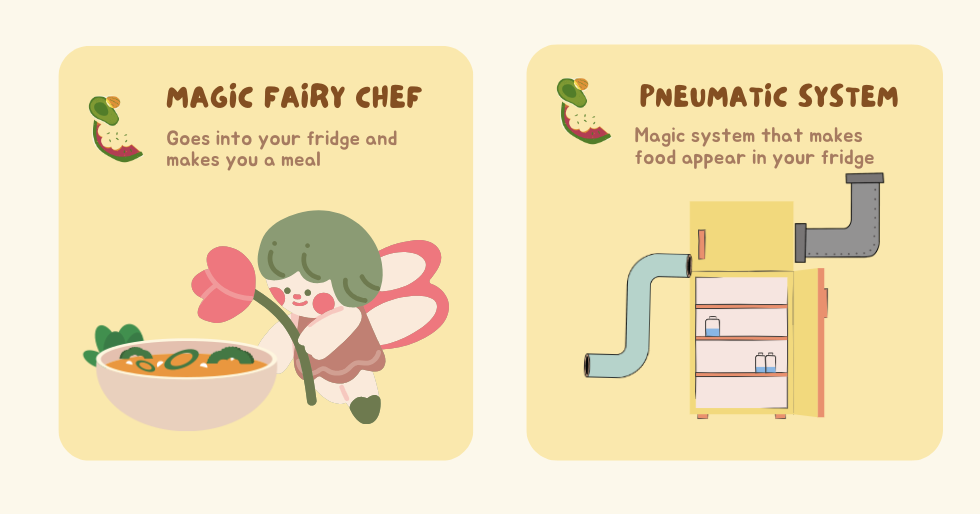
Prioritization Grid
- Here, we voted based on feasibility and impact.
- Each member was given 3 dots for each criterion, 6 in total.
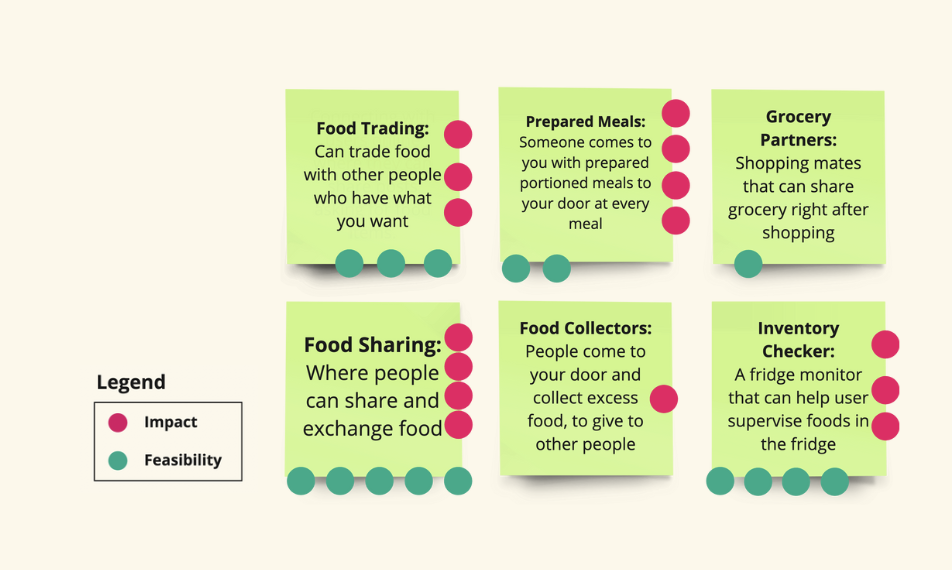
- With the information, we plotted each idea on its corresponding position on one prioritization grid, shown here.
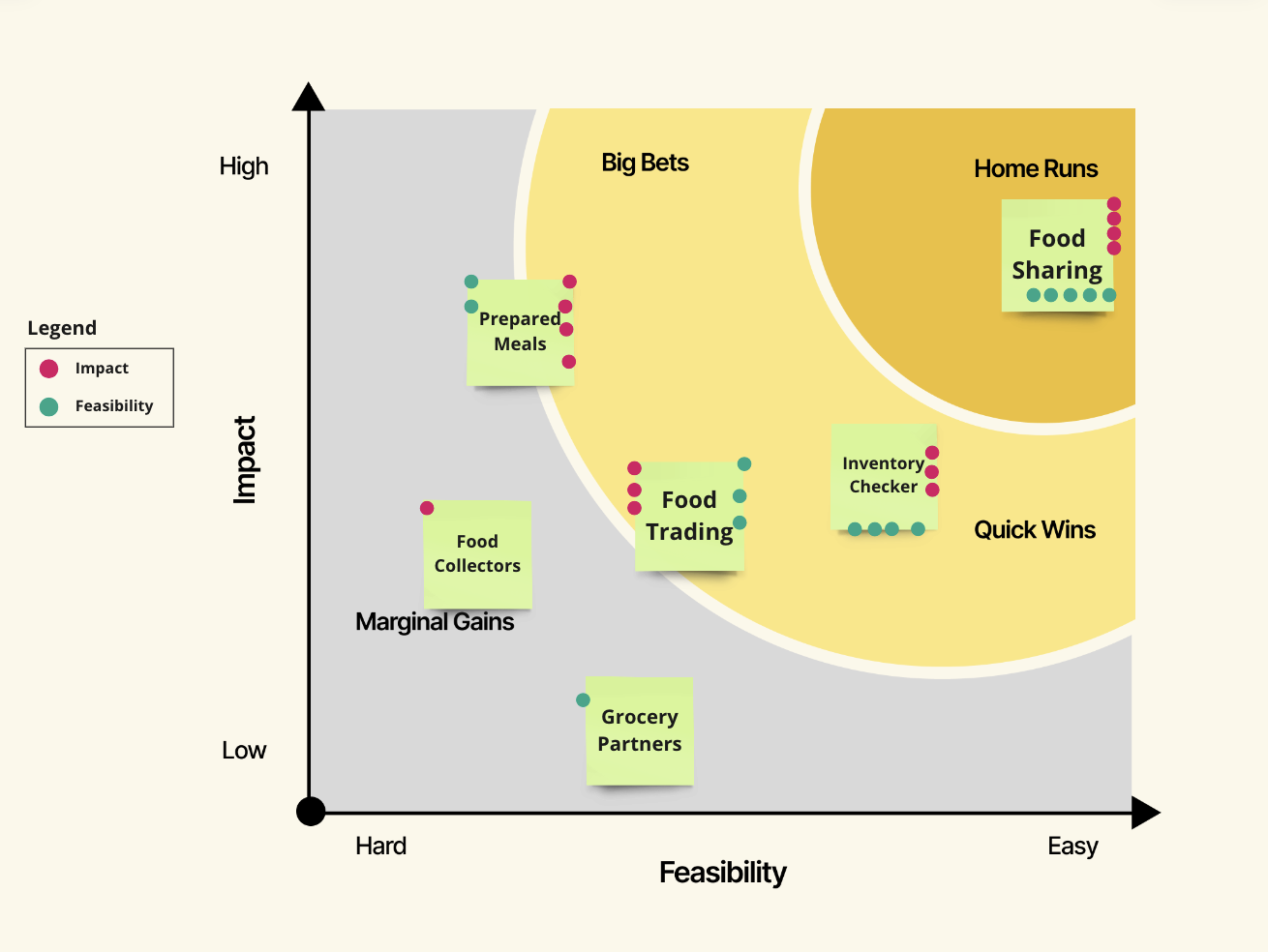
- "Food Sharing" is in Home Runs, which is the obvious choice that we will further develop in our design.
- "Prepared Meals" is in Big Bets with a large impact but not easy to achieve.
- "Inventory Checker” is our Quick Wins, easy to achieve but relatively less impactful.
- “Food trading” has fewer dots than “Inventory Checker” and "Prepared Meals", in the middle of Big Bets and Quick Wins.
- Marginal Gains include "Food Collectors" and "Grocery Partners", which did not get many votes.
To-Be-Scenario
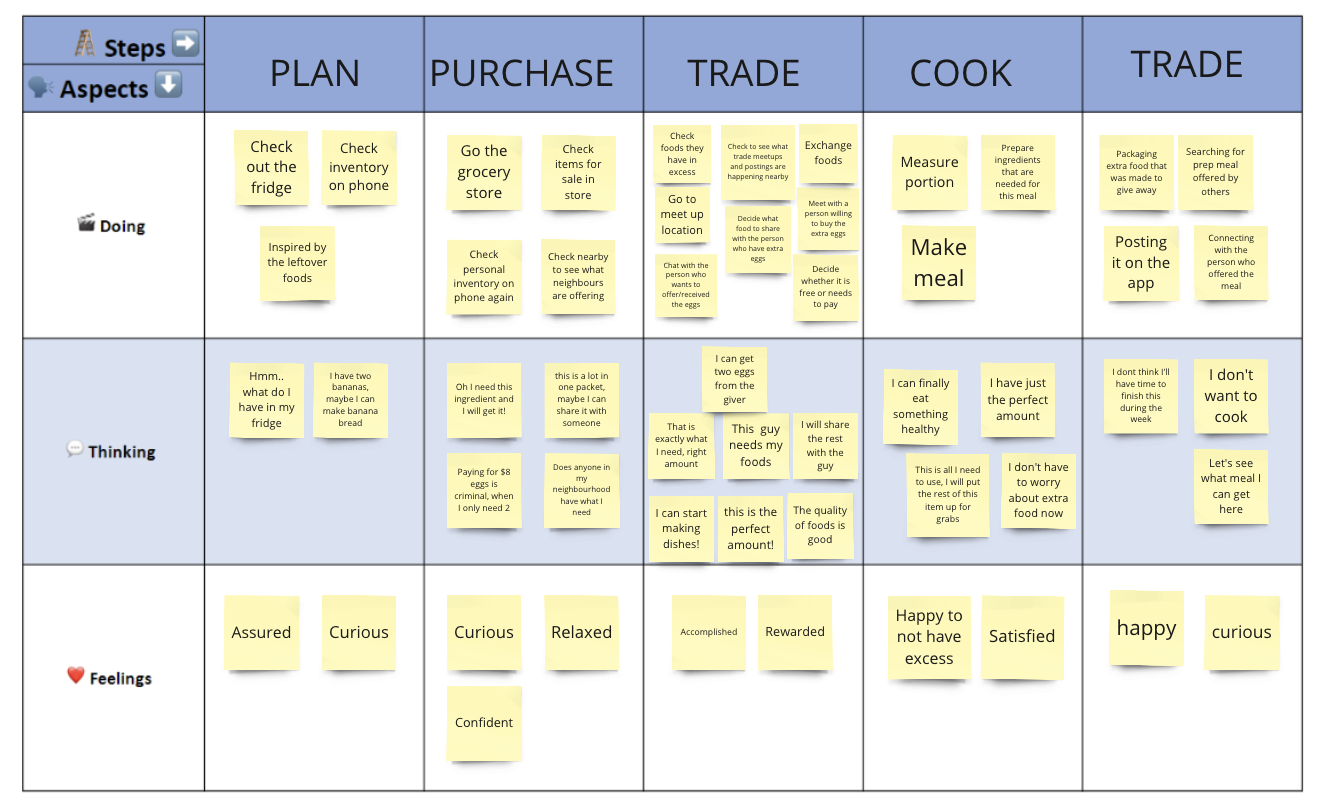
- Our to-be scenario shows what our user is doing, thinking and feeling throughout each step of the process.
- By adding a trading step before cooking, the user gains one more option for obtaining (or giving) food, diminishing unnecessary food waste, and perfecting the eating experience.
Prototyping
Lo-fi prototype
Now that we had all the raw data, I could make a plan on how to go ahead with the prototyping. I chose Figma as the software to work in since this project required a lot of collaboration.
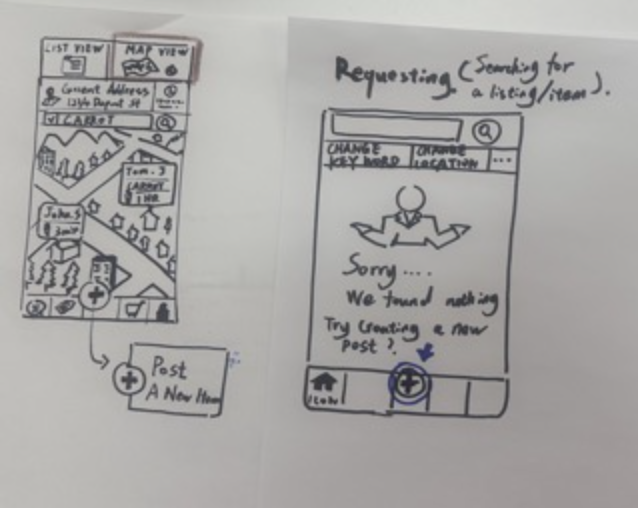
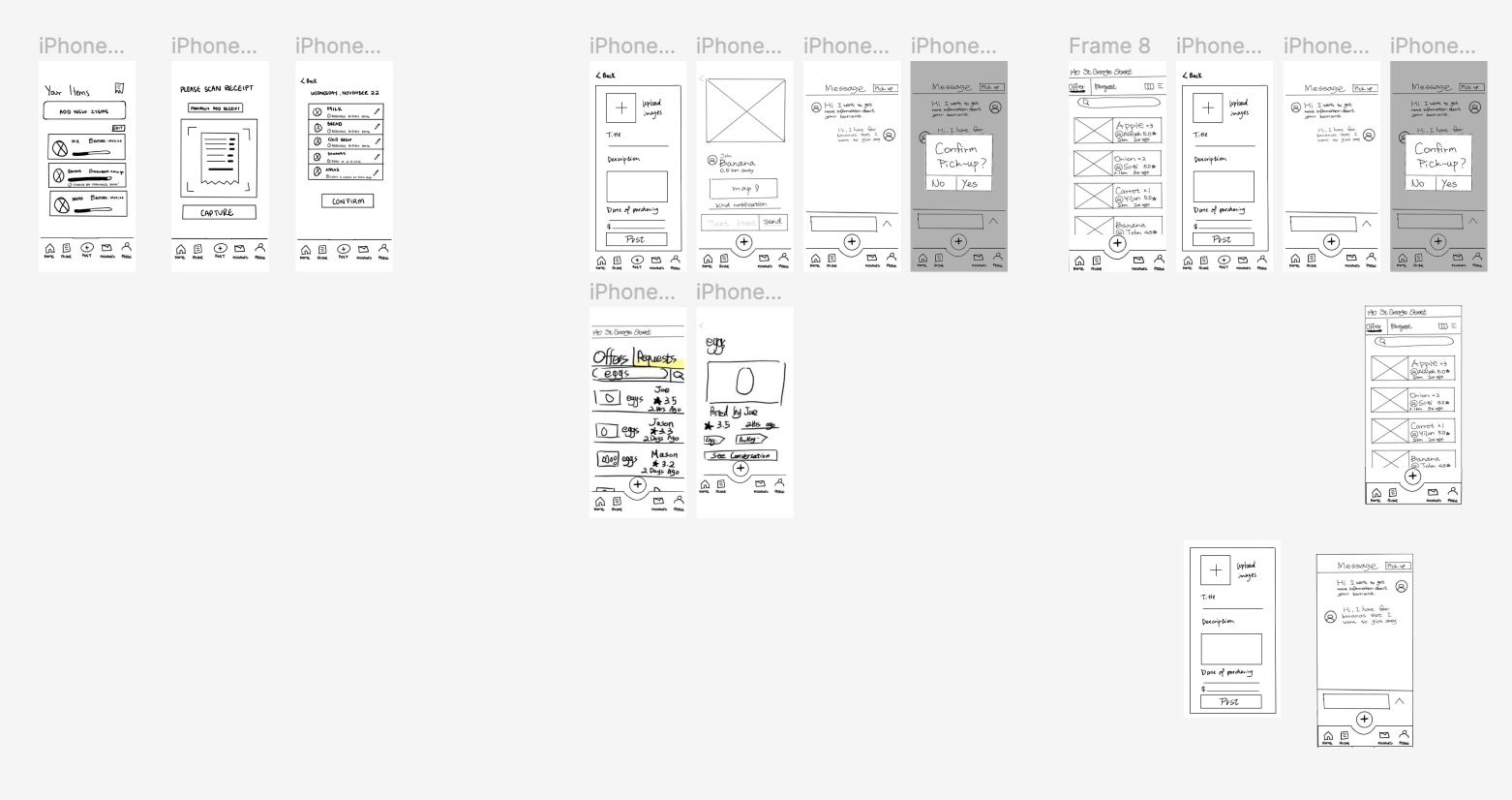
Since we only wanted to build a skeleton lo-fi format, we only considered the”happy path” for the user going through the app without any errors. Below are some examples of Penny’s experience while requesting/offering food and when she scans receipts to maintain an account of the groceries she already has.

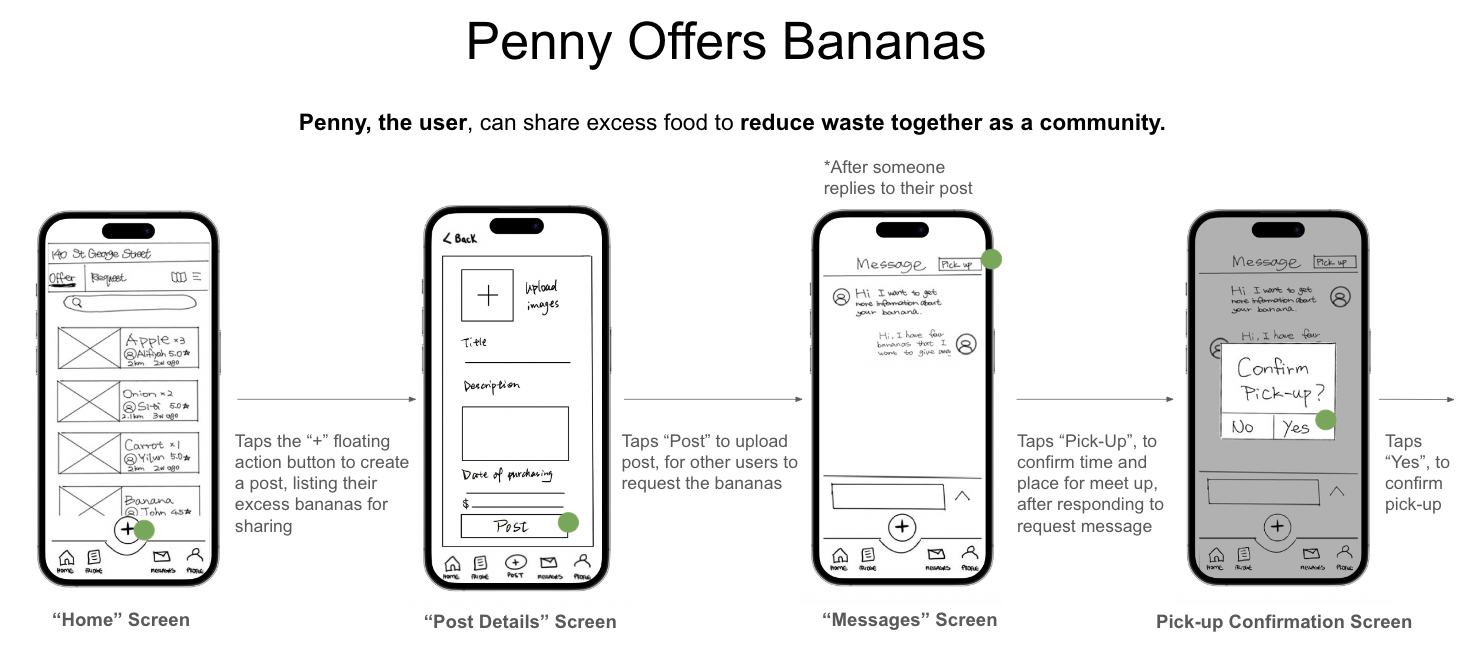
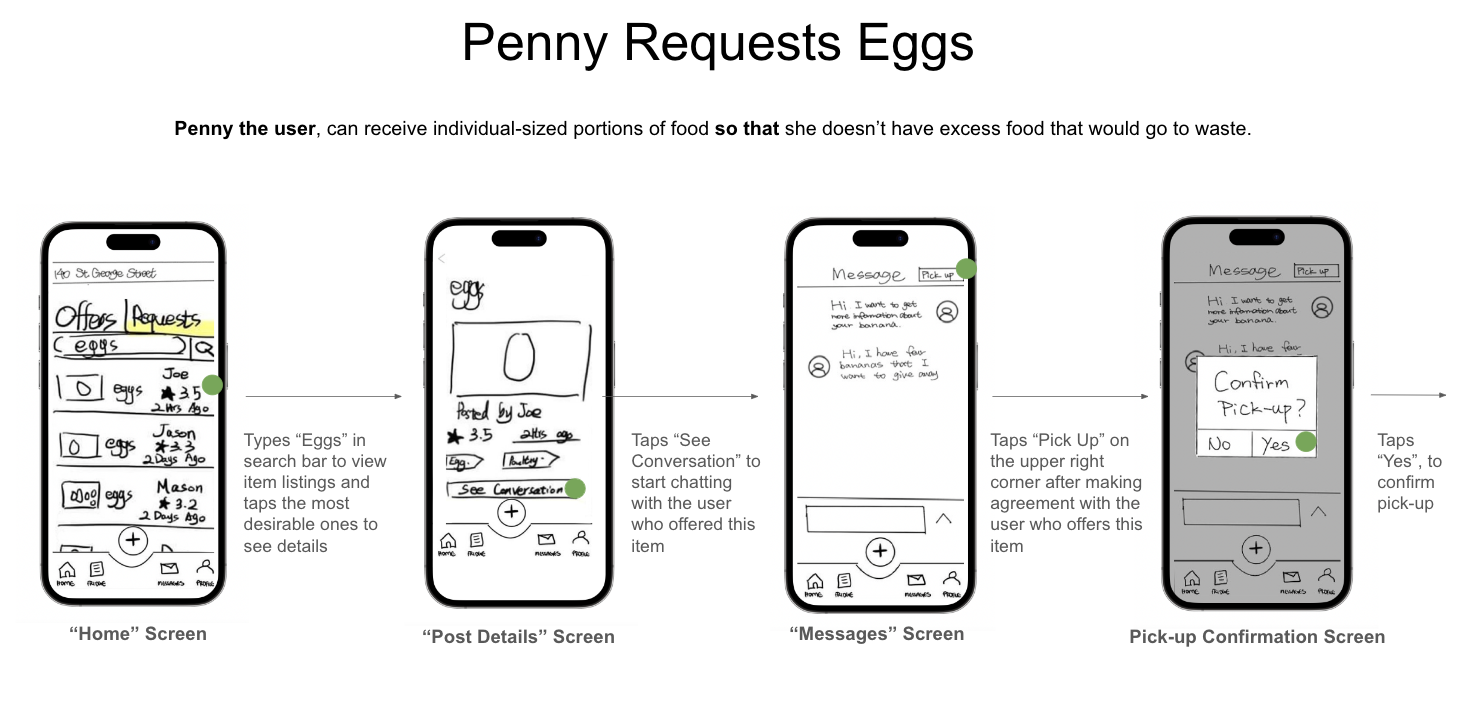
Mid-fi Prototype
We created the 3 most important tasks for our test, and every participant was asked to complete all of them if they were able to.
1. Itemize grocery receipt: Users were asked to use our receipt scanner feature to import the list of groceries.
2. Offer Food: Users were asked to offer excess food to other people by creating a post offering a food item.
3. Request Food: Users were asked to respond to a post requesting food.

Receipt Scanning Process

Requesting Process

Posting Food Offer
The user testing took place via Zoom and Discord. Users were recruited anonymously (only discord ID's available, which had no personal identifying characteristics) on various discord channels, and were sent links through the screen sharing functionality.
The hotspot functionality on Figma was disabled prior to testing, as we did not want users to be swayed by the hotspots when testing, and to select screen elements based on their own understanding of the prompts.
Interactive Prototype
Since my group had allotted enough time to finish each required part of the submission I also decided to go ahead and create a high-fidelity version (with a TON of help from my team.)
Evaluation & Next Steps
Our Goal
For this project, our aim is to develop a mobile application that facilitates the sharing and discovery of food among individuals. The app will enable users to easily share their purchased food while also discovering and connecting with food from others in their community.
Our primary goal is to repurpose surplus food that individuals can not consume, thereby contributing to the reduction of food waste in the city of Toronto, fostering a community-driven platform where sharing excess food becomes a means to minimize wastage and promote a sustainable approach to consumption. Moreover, by encouraging interactions centered around sharing food, our aim is to strengthen bonds within the community, promoting a sense of belonging and collaboration among its members.
Our Questions
Based on our established goals and the insights gathered from research analysis, ideation, and prototyping phases, we've formulated three key questions for our participants to complete during the testing phase. These questions are strategically designed to gather valuable feedback and insights crucial to refining and improving our app's functionality and user experience.
Evaluation Method
The formative evaluation of the mid-fidelity prototype will use 2 types of evaluation methods.
Real-Time Task Based: This method requires tasks that the user will be asked to do during the evaluation. We have selected this method because it allows us to quantify the testing data and see which tasks were the most objectively challenging for participants to accomplish, and what the success rate is for each task. This quantitative method needs a high user involvement.
Cognitive Walkthroughs: This method is think-out-loud, and allows participants to articulate their thoughts as they go through the prototype. We selected this method because it will provide us with qualitative data, which would give us a more nuanced understanding of the current experience of the app. This qualitative method needs a high user involvement.
Our Representative User
Based on our primary and secondary research, we've decided to narrow down the representative user group to adults (students and young professionals) who live alone in Toronto and/or buy groceries for themselves only.
Many of them are having challenges with keeping food wastage low and purchasing a proper amount of food they can consume completely.
In the usability testing process, we adhered to our strategies for identifying specific and targeted participants from our personal networks. As a result, we received feedback from four participants who actively engaged in the evaluation and offered valuable advice, enabling us to gain a better understanding of the current user experience of the application.
User Testing Preparation
We created the 3 most important tasks for our test, and every participant was asked to complete all of them if they were able to.
1. Itemize grocery receipt: Users were asked to use our receipt scanner feature to import the list of groceries.
2. Offer Food: Users were asked to offer excess food to other people by creating a post offering a food item.
3. Request Food: Users were asked to respond to a post requesting food.
Testing Conditions
The user testing took place via Zoom and Discord. Users were recruited anonymously (only discord IDs available, which had no personal identifying characteristics) on various discord channels, and were sent links through the screen-sharing functionality.
The hotspot functionality on Figma was disabled before testing, as we did not want users to be swayed by the hotspots when testing, and to select screen elements based on their understanding of the prompts.
Ethical Consideration
To adhere to an ethical standard for user testing, no personal information was collected, before, during or after testing.
Consent was obtained before each testing session.
Each member ensured that they were using neutral language when prompting users or when asking questions. This is so that our reactions or tone of voice does not sway users.
Lean Evaluation

After analyzing our usability testing results, we found out that all 4 participants had no issues completing all three tasks. They were able to complete the task as designed, however, we still received feedback on the areas of the app that were the most confusing or difficult to navigate.
Summary of main findings:
Task 1: Itemize Receipt
Based on the feedback from our participants, we found two issues in our prototype regarding this task.
1. Unclear Button Label for "Add New Items"
2. The Edit Icon was confusing for users, as they thought they could also add new items using it.
Task 2&3: Offer food & Request food
Based on the feedback from our participants, we found two issues in our prototype regarding this task.
1. The Message colour coding was inconsistent
2. Users wonder how they could edit a pick-up request that they received
Usability Evaluation
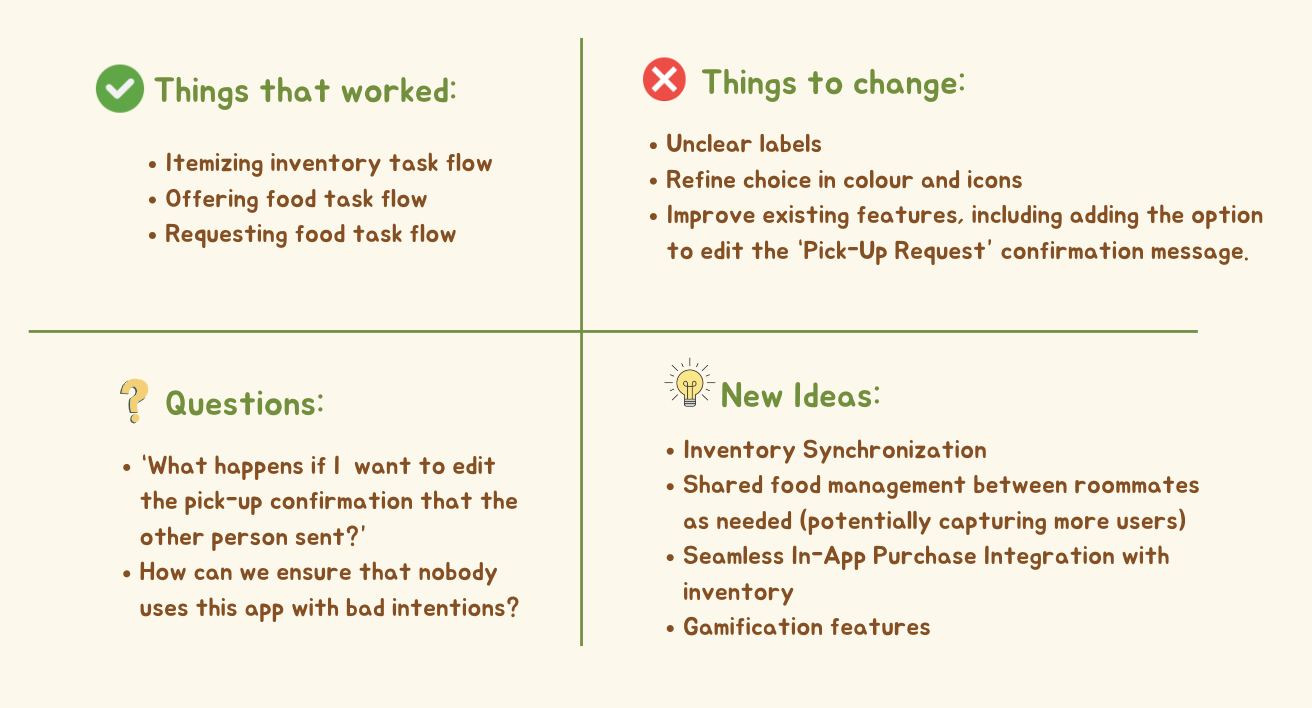
The usability evaluation results were summarized and plotted on the following grid for future reference, including the things that worked, things we should change, as well as the questions that users had during testing.
We also explored new possible ideas to increase app value for users, as well as brainstormed ideas for expanding the target audience.
Next Steps
After conducting tests with four participants, we've generated insights that inform our next course of action.
Comprehensive App Testing:
After the development of all screens, not limited to the task flows, engage users in navigating through the entire application. This will provide insights into user experience across the full scope of the app.
Iterative Design Improvements:
Based on the Analysis, reiterate. Focusing on refining the interface, user flows, and any other issues.
Develop High-Fidelity Prototypes:
The transition from the mid-fidelity design to high-fidelity prototypes. These should be detailed and closely resemble the final product, providing a realistic user experience.
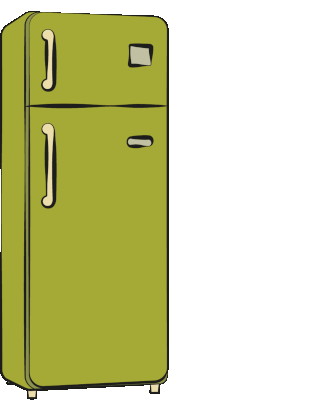
Future Ideas
During this project, our focus was on achieving the main goals and avoiding the distraction of adding too many features. However, we have identified some exciting and helpful ideas for future development.
Feature for Inventory Synchronization:
Implementing a function to sync inventory between roommates could enhance their collective food management.
Seamless In-App Purchase Integration with Inventory List:
Automatically updating the inventory list upon making in-app purchases
Introduce Gamification:
Implementing a rewards system for users who finish their food, share, or collect excess food from others could motivate more participation
